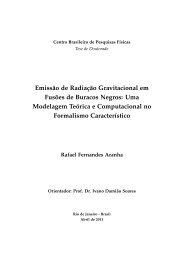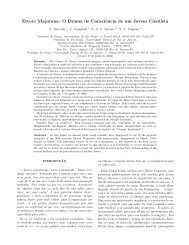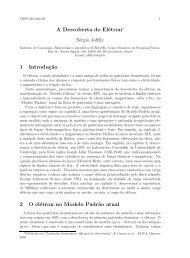Expoente de Lyapunov para um Gás de Lennard–Jones - CBPFIndex
Expoente de Lyapunov para um Gás de Lennard–Jones - CBPFIndex
Expoente de Lyapunov para um Gás de Lennard–Jones - CBPFIndex
Create successful ePaper yourself
Turn your PDF publications into a flip-book with our unique Google optimized e-Paper software.
124<br />
on<strong>de</strong> T ∗ = T/(ε/κB). Temos então ε/κB como unida<strong>de</strong> fundamental <strong>de</strong> temperatura.<br />
Notemos que a energia total E em unida<strong>de</strong>s reduzidas se escreve:<br />
E ∗ = K ∗ + U ∗ = 1<br />
2<br />
N<br />
i =1<br />
v ∗2<br />
i +<br />
N<br />
<br />
1<br />
4<br />
(r∗ 1<br />
12 −<br />
)<br />
i < j<br />
(r ∗ ) 6<br />
Por sua vez, a distribuição <strong>de</strong> Maxwell <strong>de</strong> velocida<strong>de</strong>s, utilizada no capítulo 5, em unida<strong>de</strong>s<br />
reduzidas fica:<br />
3/2 m<br />
P (v, T) = 4π v<br />
2πκBT<br />
2 2 m v <br />
−<br />
e 2κBT ∗ ∗ ∗ 1<br />
−→ P (v , T ) = 4π<br />
2πT ∗<br />
3/2 v ∗2 e −<br />
v∗2 2T ∗<br />
on<strong>de</strong> P ∗ (v ∗ , T ∗ ) = P (v ∗ , T ∗ )/ ε/m .<br />
Unida<strong>de</strong> <strong>de</strong> pressão<br />
Para <strong>um</strong> gás i<strong>de</strong>al, temos:<br />
PV = NκB T ⇒ P = ρ 0 κB T<br />
Passando todas a variáveis acima <strong>para</strong> unida<strong>de</strong>s reduzidas, obtemos:<br />
P ∗ = ρ ∗<br />
0 T ∗ =<br />
σ 3<br />
ε P<br />
Temos então ε/σ 3 como unida<strong>de</strong> <strong>de</strong> pressão.<br />
Tabela E.1: Relação entre unida<strong>de</strong>s físicas e reduzidas.<br />
r ∗ = r<br />
σ<br />
T ∗ = κBT<br />
ε<br />
ρ ∗ 0 = σ 3 ρ 0<br />
h ∗ (r ∗ ) =<br />
µ ∗ =<br />
t ∗ =<br />
<br />
<br />
ε<br />
t<br />
m σ 2<br />
V ∗ = V<br />
σ 3<br />
P ∗ =<br />
σ 2<br />
ε h(r) f ∗ (r ∗ ) =<br />
σ 2<br />
ε<br />
Φ ∗lj (r ∗ ) = Φlj (r ∗ )<br />
ε<br />
µ σ∗2<br />
λ<br />
σ 3<br />
ε P<br />
σ 4<br />
ε<br />
f (r)<br />
4 σ 2 = σ<br />
ε 2 λ<br />
g ∗ 2 (r ∗ ) = g2 (r)
















